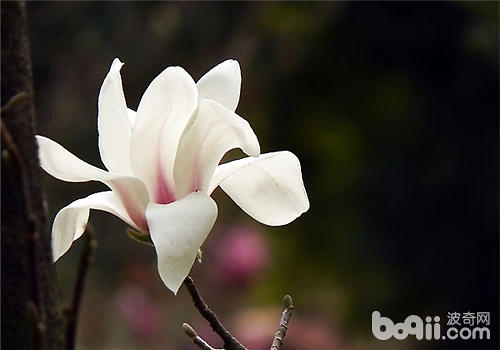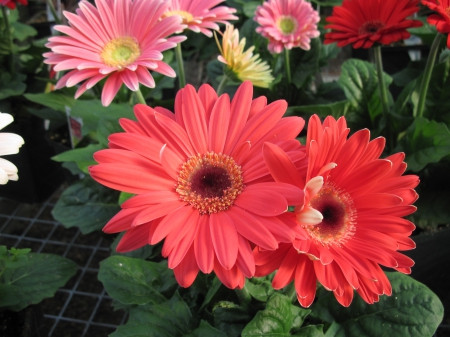Cultivation techniques of Magnolia
Cymbidium is often propagated by striping and split method. Sometimes sowing is also used. The ramets of Magnolia can be carried out in spring and autumn. The mother plants with dense branches are dug up and planted respectively, and the roots and short branches are trimmed. Striping, selected-yearly branches, can be propagated by piling soil or burying strips in early spring. Sowing, seed collection in September, sand storage in winter, spring sowing the following year, and germination 20-30 days after sowing. Cultivation and management is simple, pay attention to drought and waterlogging prevention, timely fertilization. The transplant can be carried out before flowering in autumn or early spring, the seedlings are stained with mud, and the big seedlings must carry soil balls. Fertilization was applied once before and after flowering, mainly phosphorus and potassium fertilizer. Maintain soil moisture in high temperature in summer and dry in autumn. After flowering and before sprouting new branches, dry branches, dense branches and short long branches should be cut off.
The magnolia likes the light and bears the shade slightly. Like warm and humid climate, but also can withstand cold. Like fertile, moist and well-drained sandy soil, not resistant to drought, avoid alkali, and grow poorly on dry, alkaline soil and clay. The root is fleshy, afraid of flooding, the healing of injured □ is poor, and transplanting is not easy to survive. Strong tillering. Magnolia is propagated by ramets, striping, cuttings and so on.
The transplanting of magnolia is carried out before blooming in spring or after defoliation in autumn. small and medium-sized seedlings need to stay in the soil, and large seedlings carry soil balls. Magnolia likes fertilizer, and the mature manure is used as base fertilizer from October to November every year. During the period of sprouting and branching after flowering, the available nitrogen fertilizer is applied for 2 or 3 times, and the rhizosphere is covered and watered properly in dry season. Flowers and leaves are expected to flourish in the following year.
In order for the orchid to be in the shape of a tree, it must be removed, sprouted and pruned. Magnolia root rot, red spider and drill beetle should be controlled in time.
Magnolia prefers light and is more hardy, but not drought-tolerant. It requires fertile sandy soil and is not resistant to alkali. I'm afraid of flooding. Magnolia like humid and semi-overcast climate, like fertilizer, have good permeability of soil to dig holes in winter, apply organic fertilizer, such as bone meal, cake fertilizer. Magnolia has strong cold tolerance, but avoid drought and waterlogging, usually to ensure water supply, often spray water to the leaves, increase air humidity, so as to avoid yellow leaves and fallen leaves.

Magnolia
Magnolia prefers light and is more hardy, but not drought-tolerant. It requires fertile sandy soil and is not resistant to alkali. I'm afraid of flooding. Magnolia like humid and semi-overcast climate, like fertilizer, have good permeability of soil to dig holes in winter, apply organic fertilizer, such as bone meal, cake fertilizer. Magnolia has strong cold tolerance, but avoid drought and waterlogging, usually to ensure water supply, often spray water to the leaves, increase air dampness, so as to avoid yellow leaves and fallen leaves.
The transplanting of magnolia is carried out before blooming in spring or after defoliation in autumn, small seedlings need to stay in the soil, and large seedlings carry soil balls. Mulan likes fertilizer, and the mature barnyard manure is applied as base manure from October to November every year. During the sprouting and branching period after flowering, the available nitrogen fertilizer is applied for 2 or 3 times, and the rhizosphere is covered and watered properly in the dry season. Flowers and leaves are expected to flourish in the following year.
Magnolia must be sprouted and pruned if it is to become a tree. Magnolia root rot, red spider, drill beetle and so on should be controlled in time.
What is Magnolia Flower language? a detailed explanation of the planting method of Magnolia
Magnolia is clean and simple, without too much decoration and decoration, has always been loved by people. So what are the words of magnolia? The following is a detailed analysis of the planting method and language of magnolia for you.
What is Magnolia Flower language? a detailed explanation of the planting method of Magnolia
Magnolia archives
English name: Magnolia
Scientific name: Magnolia liliflora Desr.
Aliases: Lin lan, laurel orchid, Dulan, magnolia, wooden pen, yellow heart, purple magnolia, girl flower and so on.
Family: Magnoliaceae of Magnoliaceae
Genus: Magnolia of Magnolia
Distribution of origin: Magnolia is a kind of plant, which is native to mountain mixed forest and mountain forest in central China, and is now cultivated in hillside mixed forest with an altitude of 700-1800m.
Morphological features: small deciduous trees, 5 meters high. The wood is fragrant, simple leaves alternate, Obovate-oval; flowers terminal, petals 6, purplish red on the outside, nearly white on the inside; fruit rectangular round. Root is fleshy.
It is reported that magnolia was introduced to Fusang in China during the Tang Dynasty and was introduced into Europe in the 17th century (introduced to Britain in 1790). Because of its large and beautiful flowers, it is widely spread in Europe and the United States. In the United States, the Magnolia Society has been set up because of magnolia, and now it has cultivated rich and colorful horticultural varieties of magnolia.
What is Magnolia Flower language? a detailed explanation of the planting method of Magnolia
What is the floral language of magnolia?
Magnolia trees can be up to 5 meters high, when the flowers are proud to stand on the branches, pure white and holy, because Magnolia flowers bloom first, and then grow leaves, so magnolia blossoms are full of white trees without miscellaneous colors, making people feel admired suddenly. Therefore, magnolia flower language is a noble soul.
The noble soul can be sent on teacher's Day. On teacher's Day every year, it is popular for children to give their own gifts to teachers. Greeting cards are not environmentally friendly and out of date. Sending expensive gifts is not in line with the identity of children, so it is better to send an open magnolia. To express my respect and praise for the teacher's noble soul.
Bai Juyi, a poet of the Tang Dynasty, once wrote a poem praising magnolia. The poem said, "the purple room is torn down according to rouge, and the plain and beautiful wind is greasy with powder." It's so weird that Mulan used to be a girl. " Here, Mulan borrows the ancient legendary heroine Hua Mulan.
What is Magnolia Flower language? a detailed explanation of the planting method of Magnolia
Planting methods of Magnolia
The method of striping and plant division was used to propagate. Sometimes sowing is also used. Ramet can be carried out in spring and autumn, the mother plant with dense branches can be dug out and planted separately, and the root system and short branches can be trimmed. Striping, selected from 2012 branches, can be propagated by piling soil or burying strips in early spring. Sow seeds, collect seeds in September, store sand in winter, sow in spring the following year, and germinate 20-30 days after sowing. Cultivation and management is simple, pay attention to drought and waterlogging prevention, timely fertilization. The transplant can be carried out before flowering in autumn or early spring, the seedlings are stained with mud, and the big seedlings must carry soil balls. Fertilization was applied once before and after flowering, mainly phosphorus and potassium fertilizer. Maintain soil moisture in high temperature in summer and dry in autumn. After flowering and before sprouting new branches, dry branches, dense branches and short long branches should be cut off.
Mulan likes light and is slightly resistant to shade. Like warm and humid climate, but also can withstand cold. Like fertile, moist and well-drained sandy soil, not resistant to drought, avoid alkali, and grow poorly on dry, alkaline soil and clay. The root is fleshy, afraid of flooding, the wound is getting worse, and transplanting is not easy to survive. Strong tillering. Magnolia is propagated by ramets, striping, cuttings, etc.
The transplanting of magnolia is carried out before blooming in spring or after defoliation in autumn, small seedlings need to stay in the soil, and large seedlings carry soil balls. Mulan likes fertilizer, and the mature barnyard manure is applied as base manure from October to November every year. During the sprouting and branching period after flowering, the available nitrogen fertilizer is applied for 2 or 3 times, and the rhizosphere is covered and watered properly in the dry season. Flowers and leaves are expected to flourish in the following year.
Magnolia must be sprouted and pruned if it is to become a tree. Magnolia root rot, red spider, drill beetle and so on should be controlled in time.
- Prev

Detailed explanation of planting methods of daisies
Daisies are annual herbs with cold-tolerant ecological habits and like sunny and cool climates. The planting method of daisies is more complicated. Today we will introduce in detail the planting methods of daisies. Planting method: stage -, pot seedling stage-- the radicle germination stage begins with the radicle piercing the seed coat, and the young root touches the soil
- Next

The planting method of Phoenix flower
Phoenix flower is native to the tropics, which is most suitable for planting in high temperature and humid environment, and grows in the temperature range of 20-30 degrees Celsius, so it is the most exuberant season in late spring, early summer and autumn in China. Phoenix mackerel is not cold-resistant, so plants planted in the open air should be kept warm in winter.
Related
- Fuxing push coffee new agricultural production and marketing class: lack of small-scale processing plants
- Jujube rice field leisure farm deep ploughing Yilan for five years to create a space for organic food and play
- Nongyu Farm-A trial of organic papaya for brave women with advanced technology
- Four points for attention in the prevention and control of diseases and insect pests of edible fungi
- How to add nutrient solution to Edible Fungi
- Is there any good way to control edible fungus mites?
- Open Inoculation Technology of Edible Fungi
- Is there any clever way to use fertilizer for edible fungus in winter?
- What agents are used to kill the pathogens of edible fungi in the mushroom shed?
- Rapid drying of Edible Fungi

